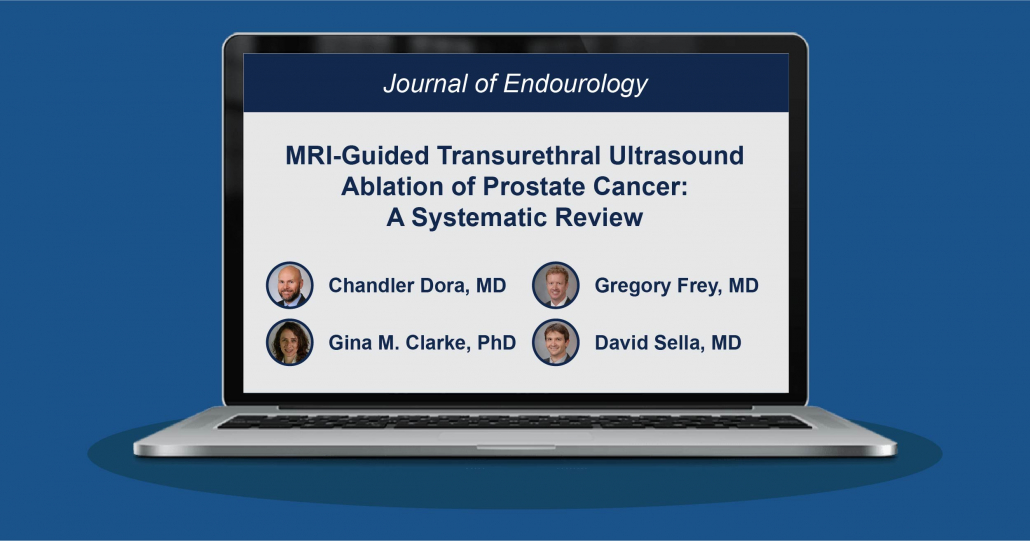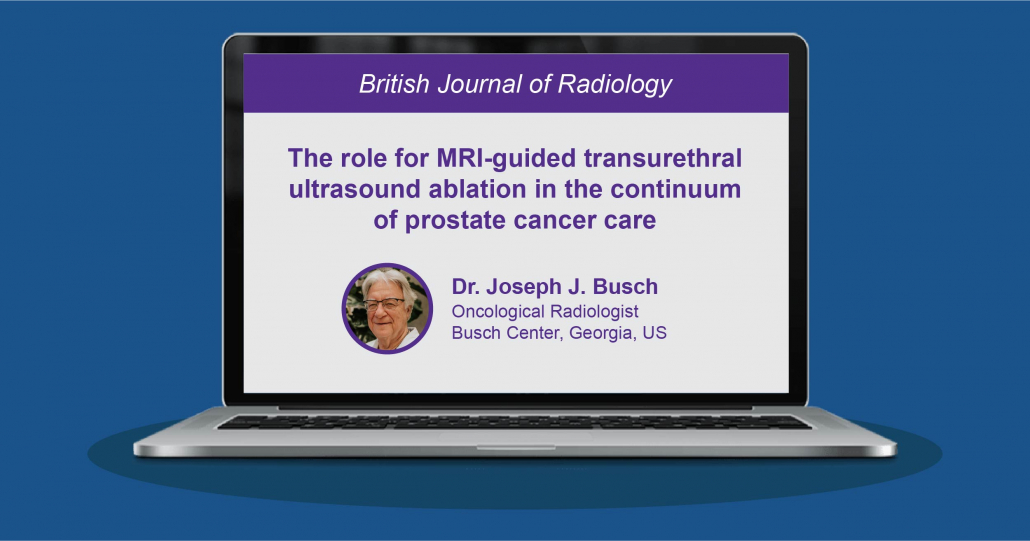Summary
Dora C., Clarke G., Frey G. et al. “MRI-Guided Transurethral Ultrasound Ablation of Prostate Cancer: A Systematic Review – Beyond the Abstract.” UroToday Prostate Cancer Articles. Online March 2022: https://www.urotoday.com/recent-abstracts/urologic-oncology/prostate-cancer/135965-mri-guided-transurethral-ultrasound-ablation-of-prostate-cancer-a-systematic-review-beyond-the-abstract.html. © 2022 DIGITAL SCIENCE PRESS, LLC
Abstract
Prostate cancer continues to have a negative impact on the duration and quality of life for males and their families. MRI is transforming the pathway of prostate cancer detection, diagnosis, staging, and surveillance, backed by multiple Level 1 studies and robust reporting standards. This evolving paradigm of MRI-directed care is now being expanded to include in-bore MRI-guided prostate tissue ablation techniques, which reduce the burden of genitourinary complications associated with standard-of-care treatments, without sacrificing cancer control. The workflow for MRI-guided transurethral ultrasound ablation relies on intraprocedural MRI guidance for treatment planning, automated and physician-monitored treatment delivery, and post-treatment assessment at both immediate and long-term time points. Our early experience has identified several procedure refinements, and aligns with early evidence from prospective clinical studies using transurethral ultrasound ablation for treatment of patients with either primary or recurrent disease. Driven by quantitative real-time imaging, MRI-guided ablative interventions provide rich datasets for developing technical refinements and predictive models that will progressively improve patient outcomes as these novel techniques become part of a new standard-of-care.
“Reproduced from Busch, J. The role for MRI-guided transurethral ultrasound ablation in the continuum of prostate cancer care. Br J Radiol Mar 1;95(1131):20210959. doi: 10.1259/bjr.20210959. Reproduced under CC-BY license. No changes were made”.
Featured Presentations
MRI-Guided Transurethral Ultrasound Ablation (TULSA): Not just another focal therapy
FOCAL 2022 Annual Meeting
Summary
Summary: Comprehensive presentation of TULSA Procedure clinical data including TACT 4-year follow-up results demonstrating durable outcomes, stable PSA, favourable adverse event profile, and continued recovery of erectile and urinary function.
Reference: Klotz, FOCAL 2022 Annual Meeting, TACT 4-year follow-up data included in “MRI-Guided Transurethral Ultrasound Ablation (TULSA): Not just another focal therapy”
Clinical Outcomes for Localized Prostate Cancer
Primary Evidence of Safety & Efficacy: TACT Pivotal Study (n=115)
Klotz et al, “MRI-guided transurethral ultrasound ablation of prostate cancer,” The Journal of Urology (2021).
Primary TACT publication demonstrating effective tissue ablation and PSA reduction with low rates of toxicity and residual disease.
Klotz et al, AUA 2021 Annual Meeting (abstract MP46-03) “Pivotal trial of MRI-guided transurethral ultrasound ablation in men with localized prostate cancer: three-year follow-up”
Preliminary 3y outcomes show stable PSA, a favourable adverse event profile, and continued recovery of erectile and urinary function.
Sundaram et al, “MRI-guided transurethral ultrasound ablation of localized prostate cancer: preliminary experience from a single center in a prospective, multi-center, single-arm clinical trial,” Journal of Vascular and Interventional Radiology (2020)
Single-center TACT experience from Vanderbilt University Medical Center.
Confirmation of Safety & Efficacy in Routine Clinical Practice (n=52)
Lumiani et al, “Single center retrospective analysis of fifty-two prostate cancer patients with customized MR-guided transurethral ultrasound ablation (TULSA),” Urologic Oncology (2021)
Rate of treatment success for cancer was similar to the pivotal study, even though 79% of men received partial gland treatment. Potency and continence preservation were 98%. The subset of patients treated for concurrent benign prostatic hyperplasia experienced a high degree of relief in lower urinary tract symptoms with all patients discontinuing medication.
Durability of Outcomes and Feasibility of Salvage Treatment: Phase I Safety & Precision Study (n=30)
Chin et al, “Magnetic resonance imaging-guided transurethral ultrasound ablation of prostate tissue in patients with localized prostate cancer: A prospective Phase 1 clinical trial,” European Urology (2016)
Primary Phase I publication demonstrating favourable safety and quality of life outcomes to 12 months. PSA and biopsy outcomes in accordance with 90% prostate treatment plan.
Bonekamp et al, “Twelve-month prostate volume reduction after MRI-guided transurethral ultrasound ablation of the prostate,” European Radiology (2018)
Supporting publication focused on imaging findings including 88% prostate volume reduction in accordance with treatment plan.
Nair et al, “MRI-guided transurethral ultrasound ablation in patients with localized prostate cancer: Three year outcomes of a prospective Phase I study,” BJU International (2020)
Consistent biopsy results at 3 years compared to those at 12 months. No new serious or severe adverse events to 3 years. Urinary, bowel function remained stable from 12 months, and erectile function recovered by 1 year and stable to 3 years.
Chin et al, “Five-year Outcomes from a Prospective Phase I Study of MRI-guided Transurethral Ultrasound Ablation in Men with Localized Prostate Cancer,” AUA 2020 Annual Meeting (abstract PD17-03) & EAU 2020 Virtual Congress (abstract 884).
5 year outcomes demonstrate durability of the data. Patients without residual disease are stable on PSA to 5 years, and continue to see favorable safety and quality of life. Patients with residual disease progressed as expected and some underwent salvage treatment for their prostate cancer. Residual disease was feasible to detect and radical, salvage options were safe and effective. 100% cancer specific survival and 97% overall survival at 5 years.
Nair et al, “Salvage open radical prostatectomy for recurrent prostate cancer following MRI-guided transurethral ultrasound ablation (TULSA) of the prostate: feasibility and efficacy,” Scandinavian Journal of Urology (2020)
Report of post-TULSA salvage prostatectomy experience. Procedure is feasible and less complicated than post-radiation salvage prostatectomy.
Hatiboglu et al, “Magnetic resonance imaging‑guided transurethral ultrasound ablation of prostate tissue in patients with localized prostate cancer: single‑center evaluation of 6‑month treatment safety and functional outcomes of intensified treatment parameters,” World Journal of Urology (2019)
Compares single-center patients under Phase I versus TACT treatment planning protocols. TACT protocol shows improved efficacy with similar favorable safety profile.
Demonstrating Feasibility in other Prostate Disease States
Benign Prostatic Hyperplasia (BPH), Relief of Lower Urinary Tract Symptoms (LUTS)
Viitala et al, “MRI-guided transurethral ultrasound ablation for BPH: 12-month clinical outcomes of a phase I study”, British Journal of Urology International (2021)
Outcomes of an investigator-initiated, prospective study of TULSA in men with BPH. Lower urinary tract symptoms (IPSS) improved by 82% at 12 months, with patient-characterized quality of life related to urinary symptoms improving from ‘mostly dissatisfied’ to ‘pleased’ or ‘delighted’. There were no complications related to sexual or bowel function.
Elterman et al, “Relief of lower urinary tract symptoms after MRI-guided transurethral ultrasound ablation (TULSA) for localized prostate cancer: Subgroup analyses in patients with concurrent cancer and benign prostatic hyperplasia,” Journal of Endourology (2020)
BPH sub-group analysis of Phase I cancer study. IPSS improved significantly by 58% from 16.1 to 6.3 at 12 months (p=0.003), with at least a moderate (≥6 points) reduction in 8/9 patients.
Radio-Recurrent Localized Prostate Cancer: Phase I Study of Salvage TULSA (n=11)
Anttinen et al, “Salvage MRI-guided TULSA for localized radio-recurrent prostate cancer: 12-month functional and oncological results,” European Urology Open Science (2020)
Initial outcomes of TULSA for salvage ablation in men with radio-recurrent localized prostate cancer.
Palliation of Symptomatic Locally Advanced Prostate Cancer: Phase I Study of Palliative TULSA (n=10)
Anttinen et al, “Palliative MRI-guided transurethral ultrasound ablation for symptomatic locally advanced prostate cancer,” Scandinavian Journal of Urology (2020)
Palliation of urinary retention and intractable hematuria in patients with locally advanced prostate cancer.
Validation of Treatment Effect, Treat-and-Resect Studies (n=19, 3 cohorts)
University of Turku, Lesion-Targeted Ablation with Prostatectomy at 3 Weeks (n=6)
Anttinen et al, “Feasibility of MRI-guided transurethral ultrasound for lesion-targeted ablation of prostate cancer,” Scandinavian Journal of Urology (2019)
Treat-and-resect study (n=6), TULSA followed by prostatectomy at 3 weeks, lesion-targeted ablation, including demonstration of histological efficacy of TULSA in men with high-risk disease.
Anttinen et al, “Histopathological evaluation of prostate specimens after thermal ablation may be confounded by the presence of thermally-fixed cells,” International Journal of Hyperthermia (2019)
Case study of the above trial, demonstrating the presence of “thermally fixed” cells which can appear normal on standard histology but are in fact non-viable.
Makela et al, “Acute and subacute prostate MRI findings after MRI-guided transurethral ultrasound ablation of prostate cancer,” Acta Radiologica (2020)
MRI findings in the first three weeks after TULSA treatment for men in the Turku treat-and-resect study and determine optimal parameters for post-treatment imaging.
Sunnybrook Hospital, First-in-Man Treat-and-Resect Studies (n=13, 2 cohorts)
Ramsay et al, “Evaluation of focal ablation of MRI-defined prostate cancer using MRI-controlled transurethral ultrasound therapy with prostatectomy as the reference standard,” Journal of Urology 197: 255-261 (2017)
Second treat-and-resect study (n=5), TULSA followed by prostatectomy on the same day, lesion-targeted ablation.
Chopra et al, “MR Imaging-controlled transurethral ultrasound therapy for conformal treatment of prostate tissue: Initial feasibility in humans,” Radiology 265(1): 303-13 (2012)
First-in-man study (n=8), TULSA followed by prostatectomy on the same day, not targeting cancer.
Review
Galgano et al, “MR-guided high-intensity directional ultrasound ablation of prostate cancer”, Curr Urol Rep (2021)
Arcot et al, “Does MRI-guided TULSA provide a targeted approach to ablation?”, Nat Rev Urol (2020)
Sundaram et al, “Therapeutic ultrasound and prostate cancer,” Semin Intervent Radiol (2017)
Dora et al, MRI-Guided Transurethral Ultrasound Ablation of Prostate Cancer: A Systematic Review, Journal of Endourology, ahead of print (2022)
Pre-Clinical
Burtnyk et al, “Magnetic resonance image guided transurethral ultrasound prostate ablation: A preclinical safety and feasibility study with 28-day follow-up,” The Journal of Urology 193: 1669-1675 (2015)
Sammet et al, “Cavernosal nerve functionality evaluation after magnetic resonance imaging-guided transurethral ultrasound treatment of the prostate,” World Journal of Radiology 7(12): 521-530 (2015)
Siddiqui et al, “MRI-guided transurethral ultrasound therapy of the prostate gland using real-time thermal mapping: initial studies”, Urology 76(6): 1506-11 (2010)
Chopra et al, “MRI-controlled transurethral therapy for localized prostate cancer”, International Journal of Hyperthermia 26(8): 804-21 (2010)
Chopra et al, “Analysis of the spatial and temporal accuracy of heating in the prostate gland using transurethral ultrasound therapy and active MR temperature feedback,” Physics in Medicine and Biology 54: 2615-33 (2009)
Chopra et al, “MRI-compatible transurethral ultrasound system for the treatment of localized prostate cancer using rotational control,” Medical Physics 35: 1346-57 (2008)
Boyes et al, “Prostate tissue analysis immediately following magnetic resonance imaging guided transurethral ultrasound thermal therapy,” The Journal of Urology 178: 1080-5 (2007)
Tang K et al, “Conformal thermal therapy using planar ultrasound transducers and adaptive closed-loop MR temperature control: demonstration in gel phantoms and ex vivo tissues,” Physics in Medicine and Biology, 52: 2905-19 (2007)
Technical Development
Suomi et al, “Transurethral ultrasound therapy of the prostate in the presence of calcifications: A simulation study,” Medical Physics (2018)
N’Djin et al, “Investigation of power and frequency for 3D conformal MRI-controlled transurethral ultrasound therapy with a dual frequency multi-element transducer,” Int J Hyperthermia 28(1): 87-104 (2012)
N’Djin et al, “Coagulation of human prostate volumes with MRI-controlled transurethral ultrasound therapy: results in gel phantoms,” Medical Physics 39(7): 4524-36 (2012)
Burtnyk et al, “Simulation study on the heating of the surrounding anatomy during transurethral ultrasound prostate therapy: A 3D theoretical analysis of patient safety”, Medical Physics 37(6): 2862-75 (2010)
Burtnyk et al, “3D Conformal MRI-controlled transurethral ultrasound prostate therapy: validation of numerical simulations and demonstration in tissue-mimicking gel phantoms”, Physics in Medicine and Biology 55(22):6817-39 (2010)
Burtnyk et al, “Quantitative analysis of 3D conformal MRI-guided transurethral ultrasound therapy of the prostate: theoretical simulations,” International Journal of Hyperthermia 25(2): 116-31 (2009)
Chopra et al, “Analysis of factors important for transurethral ultrasound prostate heating using MR temperature feedback,” Physics in Medicine and Biology 51: 827-44 (2006)
Chopra et al, “Method for MRI-guided conformal thermal therapy of prostate with planar transurethral ultrasound heating applicators,” Physics in Medicine and Biology 50: 4957-75 (2005)
CAUTION: Products shown may not be approved for sale in all jurisdictions. Rx only device.
Contact us at info@profoundmedical.com for more information regarding the regulatory status of the device.





